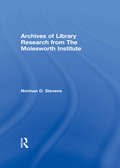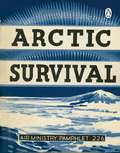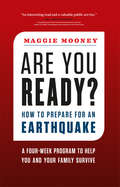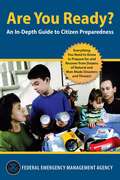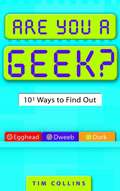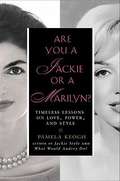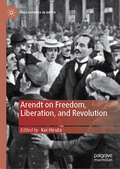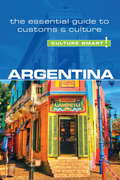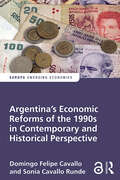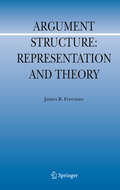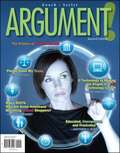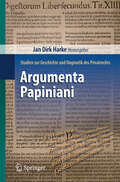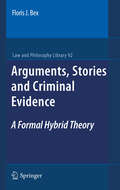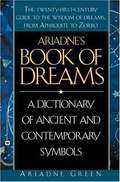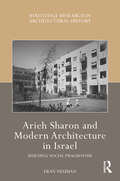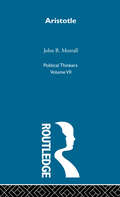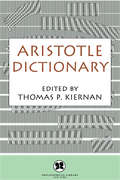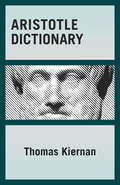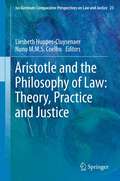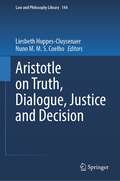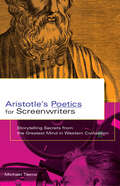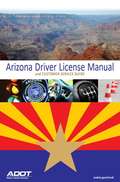- Table View
- List View
Archives of Library Research From the Molesworth Institute
by Norman D Stevens Peter GellatlyAn anthology of library humor by the director of the mythical Molesworth Institute, Norman Stevens, this book is sure to provide librarians with many hours of amusement. This collection is full of Stevens’most memorable papers describing the odd kinds of research conducted by the Institute, such as a sophisticated study of the disappearance of umbrellas in libraries, a computer analysis of library postcards, and a “precostretrieval” scheme to accelerate the disintegration of book pages while saving the letters in them. Archives of Library Research from the Molesworth Institute is also well-stocked with unforgettable one-liners, such as the author’s “plan to solve a major space problem for libraries by microfilming all Braille books.”The imaginary Molesworth Institute has taken on a life of its own since its story first appeared in the ALA Bulletin in 1963. Stevens writes mostly for fun and entertainment, but also to stress the point that librarians should take a less serious view of their work. After all, as Stevens points out in this anthology, “The library world, like the real world, [is] impossible to understand on a rational basis.” Now librarians can enjoy the convenience of having Stevens’most treasured papers--spanning over two decades--all in one very funny book.
Arctic Survival (Air Ministry Survival Guide #1)
by A.M. Pamphlet 226THE ULTIMATE SURVIVAL GUIDE for anyone who thinks they'd survive the world's most hostile environments - or at least imagine they could do.-----------------------------First issued to airmen in the 1950s, the Air Ministry's Sea Survival guide includes original and authentic emergency advice to crew operating over the ocean. With original illustrations and text, these survival guides provide an insight to military survival techniques from a by-gone era. Packed with original line drawings and instruction in:- The best faces to pull to prevent frostbite and when you can expect bits of you to 'fall off', should you fail- How to build a structurally sound igloo- How to fashion a mask to prevent snowblindnessFocussing on the harshest of situations one can find oneself in, Arctic Survival is one of four reprints of The Air Ministry's emergency survival pamphlets. Others include:Jungle SurvivalDesert SurvivalArctic Survival
Are You Ready?
by Maggie MooneyAs earthquakes have struck around the world with alarming frequency, millions have realized they are unprepared for similar catastrophes close to home. Online disaster plans and older books-heavy with seismic science and a survivalist focus-leave the average reader overwhelmed with details and anxiety. How much water will I need? What if I'm driving? How do I protect my six-year-old? The questions go on-and in this book Maggie Mooney answers them. Her four-week readiness program includes straightforward instructions, forms, and checklists. Mooney explains what to expect during a quake, and what to do when the shaking stops. She also addresses both aftershocks and tsunamis.Use this guide and the checklists inside to get ready:Find your safe spots at home, at work, at school, and outdoors.Develop your emergency communication plan.Shake-proof your home.Assemble emergency supplies. By following the steps in the four-week readiness program described here you can avoid injury and ensure you have the food, water and other essentials you need to be prepared rather than scared.
Are You Ready?: An In-Depth Guide to Disaster Preparedness
by Federal Emergency Management Agency US Department of Homeland SecurityEverything You Need to Know to Prepare for and Recover from Dozens of Natural and Man-Made Disasters and Threats!Are You Ready? is an all-encompassing practical guide for individuals and their families to preparing for all types of hazards and emergencies. It can be used as a reference or a step-by-step guide to developing, practicing, and maintaining emergency plans. It provides information, checklists, educational materials, and graphics to help you effectively plan for before, during, and after any kind of disaster. Topics covered include: • Creating a disaster supplies kit • Dealing with natural hazards such as floods, earthquakes, and tornadoes • Responding to technological hazards such as hazardous materials incidents and nuclear or chemical emergencies • General information about terrorism
Are You Sh*tting Me?
by Cary McnealBlue Ice, Meteors, and Beaver Ass, Oh My! FACT: The use of maggots to clean wounds has proven to be effective for patients who don't respond to traditional treatments. FACT: The Icelandic dish hákarl is beheaded basking shark that is buried in the ground for six to 12 weeks to putrefy before it is eaten. FACT: Used during the Dutch Revolt, rat torture involved trapping rodents under a bowl on a prisoner's stomach then heating the bowl's exterior so the animals would eat through the victim's flesh to try to escape. FACT: The average person picks his nose five times every hour, occasionally eating what he picks. The world is a scary place, and it gets scarier every day. From the creator of the bestselling 1,001 Facts That Will Scare The S#*t Out Of You comes this new collection of 1,004 (count 'em!) truly horrifying and horrifyingly true facts about the world around us. From ancient medical practices to doomsday scenarios, to disgusting food from around the world and the entire terrifying state of Florida, the facts in Are You Sh*tting Me? are sure to entertain and disturb you at once. Unless of course you are already disturbed, in which case this is the book for you!
Are You a Geek?: 1,000 Ways To Find Out
by Tim CollinsLet’s face it–we all do geeky things, from checking e-mail obsessively to playing video games to tripping over our own feet. But here’s your chance to find out just how much of a geek you really are. With 1,000 questions for every area of your life–from childhood to lifestyle to entertainment to sex (you met your wife in a Web chat room–3 points), Are You a Geek? helps measure your precise geek quotient. From challenging intelligence quizzes to testing your dating compatibility with “Geekline,” Are You a Geek? lets you in on the secrets that separate the geeks from the grown-ups. Or the nerdmeisters from everyone else…From the Trade Paperback edition.
Are You a Jackie or a Marilyn?
by Pamela KeoghRead Pamela Keogh's blogs and other content on the Penguin Community. An irresistible guide to modern-retro style, celebrating the legacies of two iconic women. The hit TV show Mad Men recently featured an ad campaign with two images of a model in her underwear. As a brunette, she sips from a china teacup. As a blonde, she swirls a cocktail. Debutante or bombshell? Sometimes women want to be both. On the surface, Jacqueline Kennedy Onassis and Marilyn Monroe could not be more different, but they had more in common than just JFK. Are You a Jackie or a Marilyn? is a fun way to explore the classic madonna/ whore conundrum while becoming fabulous in all aspects of life. Readers start by taking the definitive quiz to determine where they fall on the Jackie/ Marilyn spectrum, and then it's on to customized advice on beauty and style, sex and marriage, power and career, decorating and entertaining, and more. Any woman who has aspired to Marilyn's sultry allure or Jackie's unstoppable elegance (or who wants to balance sexy and serious) will love these entertaining lessons on channeling your inner Jackie or Marilyn in any situation, from throwing a dinner party to penning a love note. Sidebars compare Jackie's and Marilyn's dating tips, lists of favorite books and music, diet plans, and even makeup know-how. Packed with charming two-color illustrations, this is the book that gives every woman her own star power. Watch a Video .
Arendt on Freedom, Liberation, and Revolution (Philosophers in Depth)
by Kei HirutaThis edited volume focuses on what Hannah Arendt famously called “the raison d’être of politics”: freedom. The unique collection of essays clarifies her flagship idea of political freedom in relation to other key Arendtian themes such as liberation, revolution, civil disobedience, and the right to have rights. In addressing these, contributors to this volume juxtapose Arendt with a number of thinkers from Isaiah Berlin, John Rawls and Philip Pettit to Karl Marx, Frantz Fanon and Geoffroy de Lagasnerie. They also consider the continuing relevance of Arendt’s work to some of the most dramatic events in recent years, including the current global refugee crisis, the Arab uprisings of the 2010s, and the ongoing crisis of liberal democracy in the West and beyond. Contributors include Keith Breen, Joan Cocks, Tal Correm, Christian J. Emden, Patrick Hayden, Kei Hiruta, Anthony F. Lang Jr., Shmuel Lederman, Miriam Leonard, Natasha Saunders, William Smith, and Shiyu Zhang.
Argentina - Culture Smart!
by Robert HamweeCulture Smart! provides essential information on attitudes, beliefs and behavior in different countries, ensuring that you arrive at your destination aware of basic manners, common courtesies, and sensitive issues. These concise guides tell you what to expect, how to behave, and how to establish a rapport with your hosts. This inside knowledge will enable you to steer clear of embarrassing gaffes and mistakes, feel confident in unfamiliar situations, and develop trust, friendships, and successful business relationships.Culture Smart! offers illuminating insights into the culture and society of a particular country. It will help you to turn your visit-whether on business or for pleasure-into a memorable and enriching experience. Contents include* customs, values, and traditions* historical, religious, and political background* life at home* leisure, social, and cultural life* eating and drinking* do's, don'ts, and taboos* business practices* communication, spoken and unspoken"Culture Smart has come to the rescue of hapless travellers." Sunday Times Travel"... the perfect introduction to the weird, wonderful and downright odd quirks and customs of various countries." Global Travel"...full of fascinating-as well as common-sense-tips to help you avoid embarrassing faux pas." Observer"...as useful as they are entertaining." Easyjet Magazine"...offer glimpses into the psyche of a faraway world." New York Times
Argentina - Culture Smart!
by Robert HamweeThe second-largest country in South America, Argentina has been through great changes in recent years. Its journey from dictatorship to democracy has left many scars, but these are largely eclipsed by the pride and resilience of the Argentinian people, who have developed a style, a language, and a joie de vivre that are all their own. The political maelstroms the country has experienced have had a profound effect on its economy, its people, and its relationship with the rest of the world. Despite this, the generosity, warmth, and openness of the Argentinians continue to place Argentina at the top of any list of must-visit countries. Its unique geography provides a plethora of enticing and captivating destinations, from the mesmerizing wonders of the glaciers or the bucolic landscapes of the Andes valleys to the buzz and excitement of Buenos Aires, famous for its nightlife, gastronomy, and cultural life. This new, updated edition of Culture Smart! Argentina looks at the attitudes and values of the people today and how they have adapted to the challenges and events over the last decade. From their immense pride in an Argentinian pope, to their passion for football and their constant striving for political and economic stability, this book provides a key to understanding the richness and complexity of Argentinian culture. It focuses on their attitude to life, business, and family to help you adapt to their working style and practices, so that you know how to behave appropriately and what to expect in return. It touches upon how Argentinian identity has been shaped over time and the reasons behind many of the traditions, beliefs, and norms of these complicated but amazing people.
Argentina's Economic Reforms of the 1990s in Contemporary and Historical Perspective (Europa Perspectives: Emerging Economies)
by Domingo Cavallo Sonia Cavallo RundeWhy has Argentina suffered so much political and economic instability? How could Argentina, once one of the wealthiest countries in the world, failed to meet its potential over decades? What lessons can we take from Argentina's successes and failures? Argentina’s economy is - irresistibly - fascinating. Argentina's economic history - its crises and its triumphs cannot be explained in purely economic terms. Argentina's economic history can only be explained in the context of conflicts of interest, of politics, war and peace, boom and bust. Argentina's economic history is also intertwined with ideological struggles over the ideal society and the on-going struggle of ideas. The book comprises two distinct components: an economic history of Argentina from the Spanish colonial period to 1990, followed by a narrative by Domingo Cavallo on the last 25 years of reform and counter reform. Domingo Cavallo has been at the centre of Argentina's economic and political debates for 40 years. He was one of the longest serving cabinet members since the return of democracy in 1983. He is uniquely qualified to help the reader make the connection between historical and current events through all these prisms. His daughter, Sonia Cavallo Runde, is an economist specialized on public policy that currently teaches the politics of development policy. The two Cavallos offer academics and students of economics and finance a long form case study. This book also seeks to offer researchers and policymakers around the world with relevant lessons and insights to similar problems from the Argentine experience.
Argument Structure: Representation and Theory (Argumentation Library #18)
by James B. FreemanThis monograph first presents a method of diagramming argument macrostructure, synthesizing the standard circle and arrow approach with the Toulmin model. A theoretical justification of this method through a dialectical understanding of argument, a critical examination of Toulmin on warrants, a thorough discussion of the linked-convergent distinction, and an account of the proper reconstruction of enthymemes follows.
Argument!
by Erica Messenger John Gooch Dorothy U. SeylerARGUMENT! marries solid instruction in critical reading and analysis, argument, and research strategies with a visually engaging and dynamic design. ARGUMENT! teaches students how to read with a critical eye, how to think about and respond to the ideas of others, and ultimately how to craft their own effective, relevant, and engaging arguments. With ARGUMENT! students will learn how to acknowledge and respond to the complex arguments (both visual and textual) that exist all around them in addition to entering debates with their own strong and thoughtful voice.
Argumenta Papiniani: Studien zur Geschichte und Dogmatik des Privatrechts
by Jan Dirk HarkeDer besondere Einfluss der Rhetorik, den das Werk des spätklassischen Juristen Papinian kennzeichnet, hat auch das Urteil späterer Juristen über seine wissenschaftliche Leistung geprägt und gleichermaßen Anerkennung und Ablehnung provoziert. Seine Methode der Rechtsfindung zu erkunden war das Ziel einer Tagung im Kloster Bronnbach. Die hierzu geleisteten Beiträge gelten der Regelbildung und den Absurditätsargumenten bei Papinian, seiner Argumentation in Pfandrechtsfragen und bei der Testamentsauslegung, seiner Haltung zu Freilassungs- und Prositutionsverboten bei Sklavenverkäufen und der Herausbildung einer Vorform des Anwartschaftsrechts zum Schutz bedingt freigelassener Sklaven sowie schließlich seinem Werk über den Ehebruch.
Arguments, Stories and Criminal Evidence: A Formal Hybrid Theory (Law and Philosophy Library #92)
by Floris J. BexIn this book a theory of reasoning with evidence in the context of criminal cases is developed. The main subject of this study is not the law of evidence but rather the rational process of proof, which involves constructing, testing and justifying scenarios about what happened using evidence and commonsense knowledge. A central theme in the book is the analysis of ones reasoning, so that complex patterns are made more explicit and clear. This analysis uses stories about what happened and arguments to anchor these stories in evidence. Thus the argumentative and the narrative approaches from the research in legal philosophy and legal psychology are combined. Because the book describes its subjects in both an informal and a formal style, it is relevant for scholars in legal philosophy, AI, logic and argumentation theory. The book can also appeal to practitioners in the investigative and legal professions, who are interested in the ways in which they can and should reason with evidence.
Ariadne's Book of Dreams: A Dictionary of Ancient and Contemporary Symbols
by Ariadne GreenThis unique A-to-Z guide of dreams is a compendium of symbols ranging from ancient times to today, and allows for specific application by dividing dreams into three areas. Complete with an alphabetical listing of symbols and their possible meanings, it also includes techniques for dream recall and evaluation.
Arieh Sharon and Modern Architecture in Israel: Building Social Pragmatism (Routledge Research in Architectural History)
by Eran NeumanArieh Sharon and Modern Architecture in Israel: Building Social Pragmatism offers the first comprehensive survey of the work of Arieh Sharon and analyzes and discusses his designs and plans in relation to the emergence of the State of Israel. A graduate of the Bauhaus, Sharon worked for a few years at the office of Hannes Mayer before returning to Mandatory Palestine. There, he established his office which was occupied in its first years in planning kibbutzim and residential buildings in Tel Aviv. After the establishment of the State of Israel in 1948, Arieh Sharon became the director and chief architect of the National Planning Department, where he was asked to devise the young country’s first national masterplan. Known as the Sharon Plan, it was instrumental in shaping the development of the new nation. During the 1950s and 1960s, Sharon designed many of Israel’s institutions, including hospitals and buildings on university campuses. This book presents Sharon’s exceptionally wide range of work and examines his perception of architecture in both socialist and pragmatist terms. It also explores Sharon’s modernist approach to architecture and his subsequent shift to Brutalist architecture, when he partnered with Benjamin Idelson in the 1950s and when his son, Eldar Sharon, joined the office in 1964. Thus, the book contributes a missing chapter in the historiography of Israeli architecture in particular and of modern architecture overall. This book will be of interest to researchers in architecture, modern architecture, Israel studies, Middle Eastern studies and migration of knowledge.
Aristotle
by John B. MorrallFirst published in 1977 this volume is the only account published in English in the 20th century to be exclusively devoted to an interpretation of Aristotle's political thought (as distinct from commentaries, translations and works on Aristotelean philosophy in general). It places Aristotle in his background of the Greek political experience.
Aristotle Dictionary
by Thomas P. Kiernan Dagobert D. RuneAt long last a comprehensive tool in English for a better understanding of the most basic terms in Aristotle's philosophy. Interested readers, students and scholars of philosophy and of the general intellectual background of Western culture need no longer be handicapped by a lack of knowledge of Greek and Latin. A careful comparison of the original Greek, medieval and Renaissance Latin translations and a reappraisal of English usage make this work a definitive source for the precise grasp of what has been the historical Aristotle as far as the documents permit one to judge. Third Printing
Aristotle Dictionary
by Thomas KiernanAt long last, a comprehensive tool in English for a better understanding of the most basic terms in Aristotle&’s philosophy. Interested readers, students, and scholars of philosophy and of the general intellectual background of Western culture need no longer be handicapped by a lack of knowledge of Greek and Latin. A careful comparison of the original Greek, Medieval, and Renaissance Latin translations and a reappraisal of English usage make Aristotle Dictionary a definitive source for the precise grasp of what has been the historical Aristotle as far as the documents permit one to judge. A lengthy introduction by Professor Theodore E. James presents an analysis of the major works of Aristotle.
Aristotle and The Philosophy of Law: Theory, Practice And Justice (Ius Gentium: Comparative Perspectives on Law and Justice #23)
by Nuno M.M.S. Coelho Liesbeth Huppes-CluysenaerThe book presents a new focus on the legal philosophical texts of Aristotle, which offers a much richer frame for the understanding of practical thought, legal reasoning and political experience. It allows understanding how human beings interact in a complex world, and how extensive the complexity is which results from humans' own power of self-construction and autonomy. The Aristotelian approach recognizes the limits of rationality and the inevitable and constitutive contingency in Law. All this offers a helpful instrument to understand the changes globalisation imposes to legal experience today. The contributions in this collection do not merely pay attention to private virtues, but focus primarily on public virtues. They deal with the fact that law is dependent on political power and that a person can never be sure about the facts of a case or about the right way to act. They explore the assumption that a detailed knowledge of Aristotle's epistemology is necessary, because of the direct connection between Enlightened reasoning and legal positivism. They pay attention to the concept of proportionality, which can be seen as a precondition to discuss liberalism.
Aristotle on Truth, Dialogue, Justice and Decision (Law and Philosophy Library #144)
by Liesbeth Huppes-Cluysenaer Nuno M. M. S. CoelhoIn this thought-provoking book, you’ll find timeless questions explored through a fresh lens. First delving into the profound significance of Socrates’ dialogical method and the inescapable nature of conflict, it ponders the rational capacities of humanity in terms of establishing harmonious communities. But this isn’t merely a philosophical debate; it’s a pragmatic exploration of real-world challenges.No longer limiting itself to abstract theories, the book then seeks to navigate the practical terrain of science and politics. Drawing inspiration from Aristotle, renowned for his investigations into the intricate connections between theory, technology, ethics, and politics, it tackles the essential question: How can we reconcile divergent views?At the book’s core lies Aristotle’s revolutionary concept of dialogue, which portrays truth as a delicate equilibrium between opposing forces, transcending the rigid boundaries of true and false. Join this captivating journey as the author reveals the hidden paths to meaningful coexistence in a world filled with conflicting perspectives.
Aristotle's Poetics for Screenwriters: Storytelling Secrets from the Greatest Mind in Western Civilization
by Michael TiernoAn insightful how-to guide for writing screenplays that uses Aristotle's great work as a guide.Long considered the bible for storytellers, Aristotle's Poetics is a fixture of college courses on everything from fiction writing to dramatic theory. Now Michael Tierno shows how this great work can be an invaluable resource to screenwriters or anyone interested in studying plot structure. In carefully organized chapters, Tierno breaks down the fundamentals of screenwriting, highlighting particular aspects of Aristotle's work. Then, using examples from some of the best movies ever made, he demonstrates how to apply these ancient insights to modern-day screenwriting. This user-friendly guide covers a multitude of topics, from plotting and subplotting to dialogue and dramatic unity. Writing in a highly readable, informal tone, Tierno makes Aristotle's monumental work accessible to beginners and pros alike in areas such as screenwriting, film theory, fiction, and playwriting.
Arizona Driver License Manual
by Arizona Department of TransportationThe Arizona Department of Transportation Motor Vehicle Division (ADOT MVD) is pleased to provide this guide to Arizona traffic laws and information for obtaining a driver license or identification card. This manual also provides essential safety information for both new and experienced Arizona drivers.
Arizona Trivia
by James A. CrutchfieldTest your Arizona knowledge with this trivia book covering the state’s rich history, geography, sports, culture, notable figures, and more!The last continental state to enter the Union, Arizona is a fascinating place, and Arizona Trivia is full of facts to prove it. This book is the ultimate resource on the who, what, where, when, and how of the Grand Canyon State. Inside, you’ll learn the answers to intriguing questions such as: “Approximately how many rounds of golf were played in Phoenix in 2000?”, “What are the deepest and widest points of the Grand Canyon?”, and many others!
